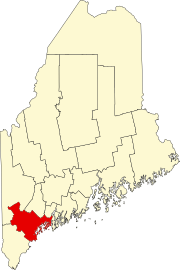43°46′12″N 69°57′54″W / 43.770°N 69.965°W

Orr's Island is an island in Casco Bay and the Gulf of Maine, part of the Atlantic Ocean. The island is within the town of Harpswell, Maine, United States, and forms an archipelago with Sebascodegan Island (also known as Great Island) to its north and Bailey Island (reached by the Bailey Island (or Cribstone) Bridge) to its south.
Orr's Island is connected to Great Island by the Orr's Island/Great Island Bridge, and is connected to the town of Brunswick on the mainland by Route 24 north over the Gurnet Bridge. Bowdoin College operates a 118-acre (48 ha) coastal studies center on Orr's Island.[1]
Demographics
[edit]As of 2010, Orr's Island had an estimated population of 539 people. 48.8% of the population was male, and 51.2% of the population was female. 98.3% of the population was white, 0.7% was Asian, 0.9% was two or more races, and 0.3% was some other race. Additionally, 90.2% of the population was 18 years or older, 32.7% was 65 years or older, and 1.7% was under 5 years of age.[2]
In Popular Culture
[edit]Orr's island is the setting for the story in the 2000 American sci-fi horror movie They Nest.
Utilities
[edit]Orr's Island, like the rest of Harpswell is served power by Central Maine Power. There is no public water or sewer on the island, with most households having septic systems and drilled wells. Communications providers include Cribstone Communications, Consolidated Communications and Comcast.
See also
[edit]Further reading
[edit]- The Pearl of Orr's Island by Harriet Beecher Stowe, 1862. ISBN 0-403-00280-X
- Brunhilda of Orr's Island by William Jasper Nicolls, 1908. ISBN 0-548-92807-X
- The Story of Orr's Island, Maine by Annie Haven Thwing. 1926.
References
[edit]- ^ "The Bowdoin Coastal Studies Center". Archived from the original on 2007-06-30. Retrieved 2009-05-21.
- ^ "American FactFinder - Community Facts". Archived from the original on 2020-02-12. Retrieved 2008-11-25.
External links
[edit]- Town of Harpswell, Maine
- Orr's Island Library
- Orr's-Bailey Yacht Club
- Orr's Island Library
- Bowdoin Coastal Studies Center

Well, that’s interesting to know that Psilotum nudum are known as whisk ferns. Psilotum nudum is the commoner species of the two. While the P. flaccidum is a rare species and is found in the tropical islands. Both the species are usually epiphytic in habit and grow upon tree ferns. These species may also be terrestrial and grow in humus or in the crevices of the rocks.
View the detailed Guide of Psilotum nudum: Detailed Study Of Psilotum Nudum (Whisk Fern), Classification, Anatomy, Reproduction